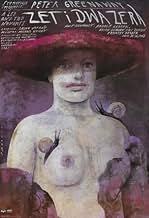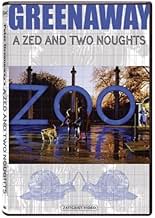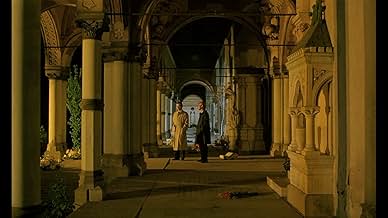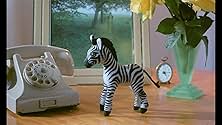Ajouter une intrigue dans votre langueTwin zoologists lose their wives in a car accident and become obsessed with decomposing animals.Twin zoologists lose their wives in a car accident and become obsessed with decomposing animals.Twin zoologists lose their wives in a car accident and become obsessed with decomposing animals.
- Director
- Writers
- Stars
Avis en vedette
All you need to make cinema is a point of view (and of course the view to which it points). Or a frame of reference and the reference which it frames. In Greenaway all these exist together, knowingly, as forms within forms.
A story of twins looking to overcome grief by studying the decay of death is the reference here. Zebras, lizards, swans, we see the empty shells of body decay before the camera. Kept under the scrutiny of our gaze in life, inside cages, they remain under it once dead. At what point do all these symmetries which conjoined together make up the miracle of life stop being the sum of their parts, and by which process; how much of these parts that we understand as the self can be taken out before the self is no longer recognized; and the symmetry once broken, what mystery renews it.
These obscure ruminations are framed against the question of existence, which implies god and pattern. How come that something so systemised, so perfectly designed and evolved from nothing, from amoeba and algea, can come to pass by the whim of chance? Having taken millions of years for creation to unravel its complexity, why does it take a second to destroy it? Which is to ask, at what point does the system, which in hindsight appears ordained and patterned, become random and meaningless.
Various eccentricities are enacted in this process, all pointing to some kind of symbolic nakedness.
When the legless woman gives birth to new life, twins again, the old twins, the blueprint for them, must step aside. The film ends with an poignant thought. Having carefully staged their own death so that the decay that follows may be captured on film, we see how nature intrudes upon this scene and foils the effort.
An atheist himself, Greenaway here gives us a pessimism that cuts deep; no consciousness survives this.
A story of twins looking to overcome grief by studying the decay of death is the reference here. Zebras, lizards, swans, we see the empty shells of body decay before the camera. Kept under the scrutiny of our gaze in life, inside cages, they remain under it once dead. At what point do all these symmetries which conjoined together make up the miracle of life stop being the sum of their parts, and by which process; how much of these parts that we understand as the self can be taken out before the self is no longer recognized; and the symmetry once broken, what mystery renews it.
These obscure ruminations are framed against the question of existence, which implies god and pattern. How come that something so systemised, so perfectly designed and evolved from nothing, from amoeba and algea, can come to pass by the whim of chance? Having taken millions of years for creation to unravel its complexity, why does it take a second to destroy it? Which is to ask, at what point does the system, which in hindsight appears ordained and patterned, become random and meaningless.
Various eccentricities are enacted in this process, all pointing to some kind of symbolic nakedness.
When the legless woman gives birth to new life, twins again, the old twins, the blueprint for them, must step aside. The film ends with an poignant thought. Having carefully staged their own death so that the decay that follows may be captured on film, we see how nature intrudes upon this scene and foils the effort.
An atheist himself, Greenaway here gives us a pessimism that cuts deep; no consciousness survives this.
Greenaway's obsessions with lists, wordplay, coincidence, sexuality, the surreal, and the explicit (not to mention the "conventionally used" ones like men and women, birth and eating and death, physiology (formal and psychological), and abstraction) come to a head in this film. A bizarre mileau of fancy digressions and focused narrativity create a film which is perhaps too obtuse for first time viewers but is, as far as I'm concerned, the best way to initiate oneself into the "world" of Greenaway.
I knew how strange and unusual Greenaway could be but Zed, I believe could take the cake :). I am not sure what it is all about but I still enjoy the triumvirate Greenaway - Sasha Verny- Michael Nyman. Some ideas and images Greenaway will use in the later "8 1/2 women" and "The Cook, The Thief, His Wife, and Her Lover" - especially, the soundtrack. "Dead Ringers" and "Mon oncle d'Amérique" (two beautiful weirdnesses themselves) also come to mind while watching Greenaway's elegant tale of decomposing which is also his meditations about life, death and grief. As in earlier "The Draughtsman's Contract (1982), Greenaway explores the relationship between the close relatives - the twin brothers are in the center of "A Zed & two Noughts". The movie is also a modern retelling of an ancient myth about Leda and Zeus who took the form of a swan and slept with Leda on the same night as her husband, King Tyndareus. Leda bore Helen and Polydeuces, children of Zeus while at the same time bearing Castor and Clytemnestra, children of her husband Tyndareus, the King of Sparta.
Greenaway considers that 90% of his films one way or another refers to paintings. "A Zed & two Noughts" refers openly and with great admiration to the paintings of Johannes Vermeer van Delft.
"A Zed & two Noughts" is not easy film to watch, its characters are not sympathetic, it lacks warmth and sentimentality but as always in Greenaway's films, it is a feast for eyes, ears, and for brain.
7.5/10
Greenaway considers that 90% of his films one way or another refers to paintings. "A Zed & two Noughts" refers openly and with great admiration to the paintings of Johannes Vermeer van Delft.
"A Zed & two Noughts" is not easy film to watch, its characters are not sympathetic, it lacks warmth and sentimentality but as always in Greenaway's films, it is a feast for eyes, ears, and for brain.
7.5/10
(Movie quote) - "So, tell me - Is a zebra a white animal with black stripes, or is it a black animal with white stripes?"
Even though I definitely found this 1985, British, "art" film to be something of a "hit'n'miss" production, it was its very striking camera-work by French cinematographer, Sacha Vierny, that certainly helped to elevate it to a position that set it well-beyond the realm of being considered just purely mundane entertainment.
Surreal, eccentric and bizarre (and, yes, at times, quite puzzling) - "A Zed And 2 Noughts" definitely had me wondering, often enough, what kind of a curve director Peter Greenaway was going to hurl at me next with this weird and somewhat disturbing tale of obsession with decaying flesh and the amputation of body parts.
Certainly not a film to please everyone (and certainly not a film with a gripping plot-line) - I, for one, thought "A Zed And 2 Noughts" was well-worth a view simply for the freakish biology lesson that it quite cleverly wedged into its wacky, little story (all at no extra cost).
Even though I definitely found this 1985, British, "art" film to be something of a "hit'n'miss" production, it was its very striking camera-work by French cinematographer, Sacha Vierny, that certainly helped to elevate it to a position that set it well-beyond the realm of being considered just purely mundane entertainment.
Surreal, eccentric and bizarre (and, yes, at times, quite puzzling) - "A Zed And 2 Noughts" definitely had me wondering, often enough, what kind of a curve director Peter Greenaway was going to hurl at me next with this weird and somewhat disturbing tale of obsession with decaying flesh and the amputation of body parts.
Certainly not a film to please everyone (and certainly not a film with a gripping plot-line) - I, for one, thought "A Zed And 2 Noughts" was well-worth a view simply for the freakish biology lesson that it quite cleverly wedged into its wacky, little story (all at no extra cost).
Peter Greenaway is arty. Painfully so. However he readily admits that this film is "self-conscious", "manufactured" and he says that all cinema is probably as "artificial" a form as you can get.
This film is beautiful to look at. Greenaway was inspired, visually, by paintings of the mid 17th century, particularly those of Vermeer. Almost every shot is composed like a painting. Many of the shots are symmetrical, walls are filmed flat so that the horizontal lines are parallel with the top and bottom of the frame. Objects are placed on tables as if subjects for a still life. Lighting is used in an alternation of light, shade,light,shade receding to the back of the picture, which is a signature of the type of 17th century, Western art that Greenaway is paying homage to.
The substance of the film follows weighty themes, all of which are explained in great detail through the director's commentary: evolution, light and twin-ship.
What is lacking is emotion. This is a cerebral film. Your emotional reaction to it will be through the imagery, be it beautiful or repulsive. You will not engage with the characters on an emotional level. You'll find them hard to relate to. The performances are stilted and amateur theatrical. It is fortunate, then, that Michael Nyman provides a fantastic score (present on almost every scene and almost outstaying its welcome) which prevents the dialogue (the script leaves a lot to be desired too) rendering everything flat.
Rent this if you enjoy visuals for their own sake, if you wear spectacles and if you like holding your chin in your hand and frowning. I qualify on all those points, so I enjoyed it a great deal.
Extra points for an extraordinarily thorough director's commentary on the DVD which serves to pull out all the hidden depths. Though one could make the point that an explanation that adds so much extra understanding leaves you feeling that the film failed adequately to convey much of what was intended.
DVD easter eggs (worth seeing): http://www.dvd.net.au/hidden.cgi?movie_id=10484
This film is beautiful to look at. Greenaway was inspired, visually, by paintings of the mid 17th century, particularly those of Vermeer. Almost every shot is composed like a painting. Many of the shots are symmetrical, walls are filmed flat so that the horizontal lines are parallel with the top and bottom of the frame. Objects are placed on tables as if subjects for a still life. Lighting is used in an alternation of light, shade,light,shade receding to the back of the picture, which is a signature of the type of 17th century, Western art that Greenaway is paying homage to.
The substance of the film follows weighty themes, all of which are explained in great detail through the director's commentary: evolution, light and twin-ship.
What is lacking is emotion. This is a cerebral film. Your emotional reaction to it will be through the imagery, be it beautiful or repulsive. You will not engage with the characters on an emotional level. You'll find them hard to relate to. The performances are stilted and amateur theatrical. It is fortunate, then, that Michael Nyman provides a fantastic score (present on almost every scene and almost outstaying its welcome) which prevents the dialogue (the script leaves a lot to be desired too) rendering everything flat.
Rent this if you enjoy visuals for their own sake, if you wear spectacles and if you like holding your chin in your hand and frowning. I qualify on all those points, so I enjoyed it a great deal.
Extra points for an extraordinarily thorough director's commentary on the DVD which serves to pull out all the hidden depths. Though one could make the point that an explanation that adds so much extra understanding leaves you feeling that the film failed adequately to convey much of what was intended.
DVD easter eggs (worth seeing): http://www.dvd.net.au/hidden.cgi?movie_id=10484
Le saviez-vous
- AnecdotesThis film was Peter Greenaway's first collaboration with cinematographer Sacha Vierny, who went on to shoot virtually all of Greenaway's work in the 1980s and 1990s, until Vierny's death in 2001. Greenaway referred to Vierny as his "most important collaborator".
- Citations
Alba Bewick: In the land of the legless the one-legged woman is queen.
- ConnexionsFeatured in Peter Greenaway (1992)
- Bandes originalesThe Teddy Bears' Picnic
Music by John W. Bratton
Lyrics by Jimmy Kennedy
Performed by The BBC Dance Orchestra
Directed by Henry Hall
Courtesy of EMI MUSIC PUBLISHING LTD and EMI RECORDS LTD
Also sung by Venus De Milo (Frances Barber)
Meilleurs choix
Connectez-vous pour évaluer et surveiller les recommandations personnalisées
- How long is A Zed & Two Noughts?Propulsé par Alexa
Détails
- Date de sortie
- Pays d’origine
- Langues
- Aussi connu sous le nom de
- A Zed and Two Noughts
- Lieux de tournage
- sociétés de production
- Consultez plus de crédits d'entreprise sur IMDbPro
Contribuer à cette page
Suggérer une modification ou ajouter du contenu manquant

Lacune principale
By what name was A Zed & Two Noughts (1985) officially released in Canada in English?
Répondre




























